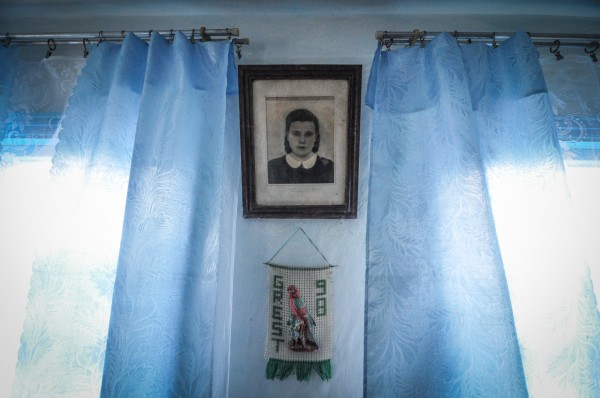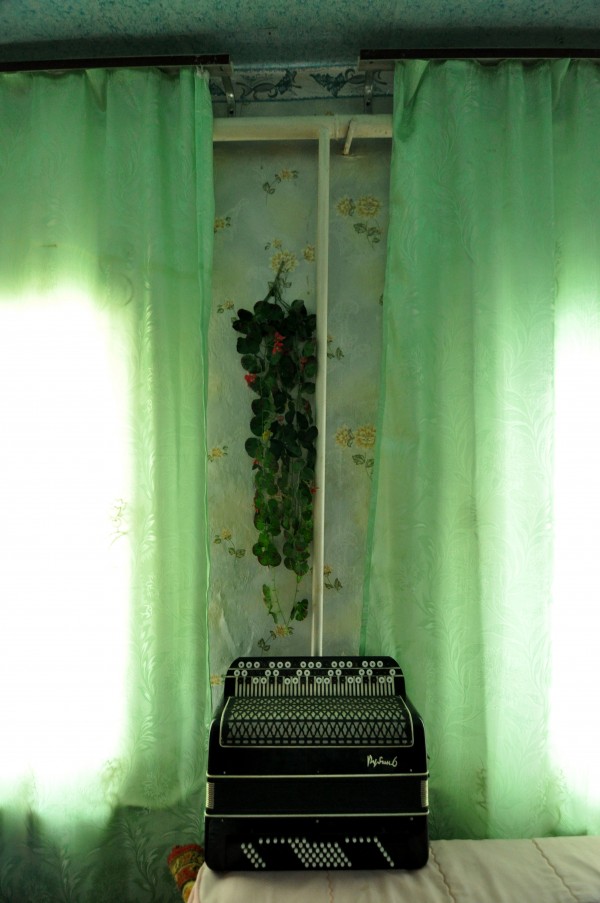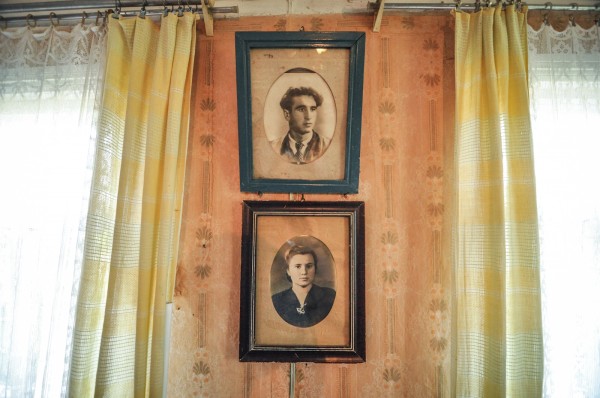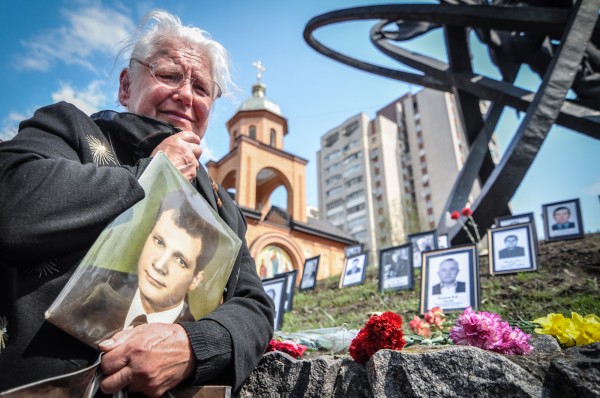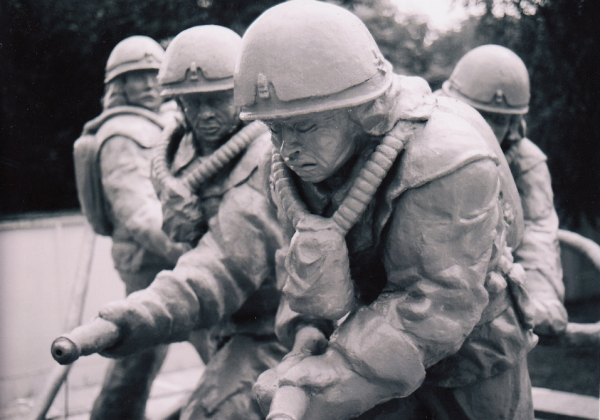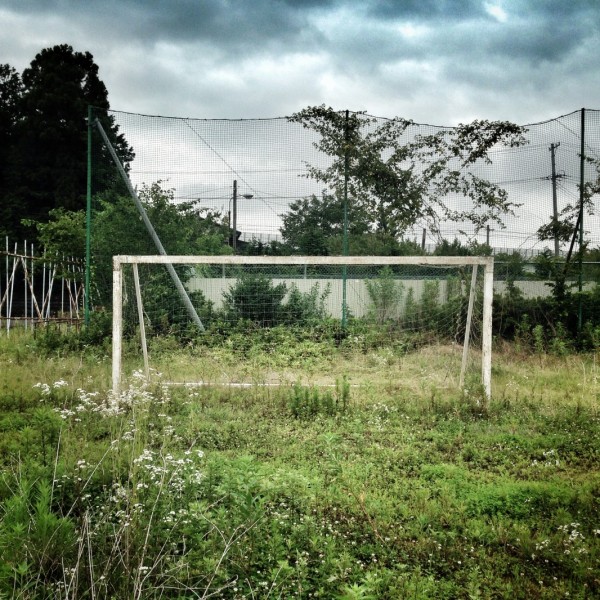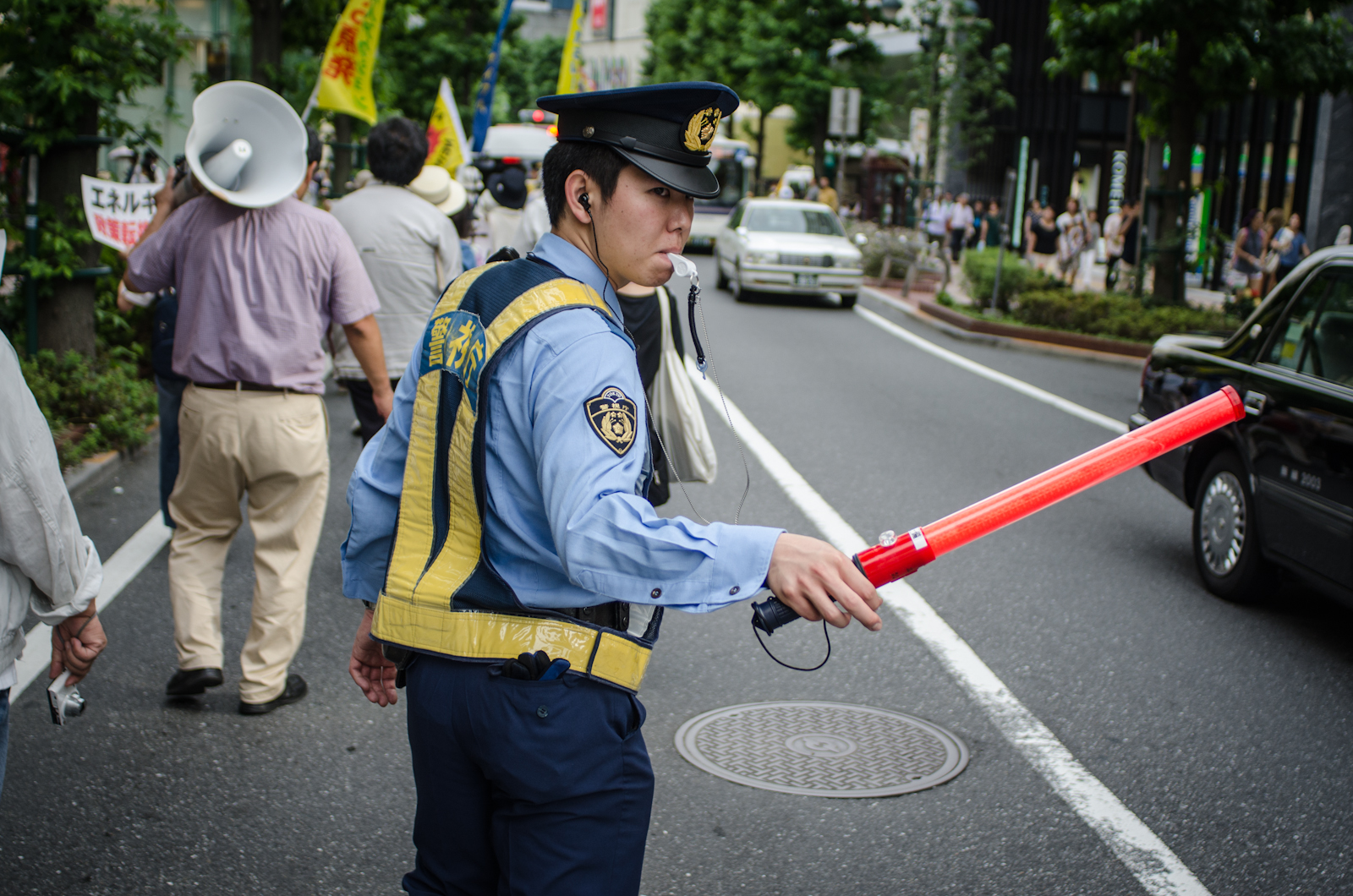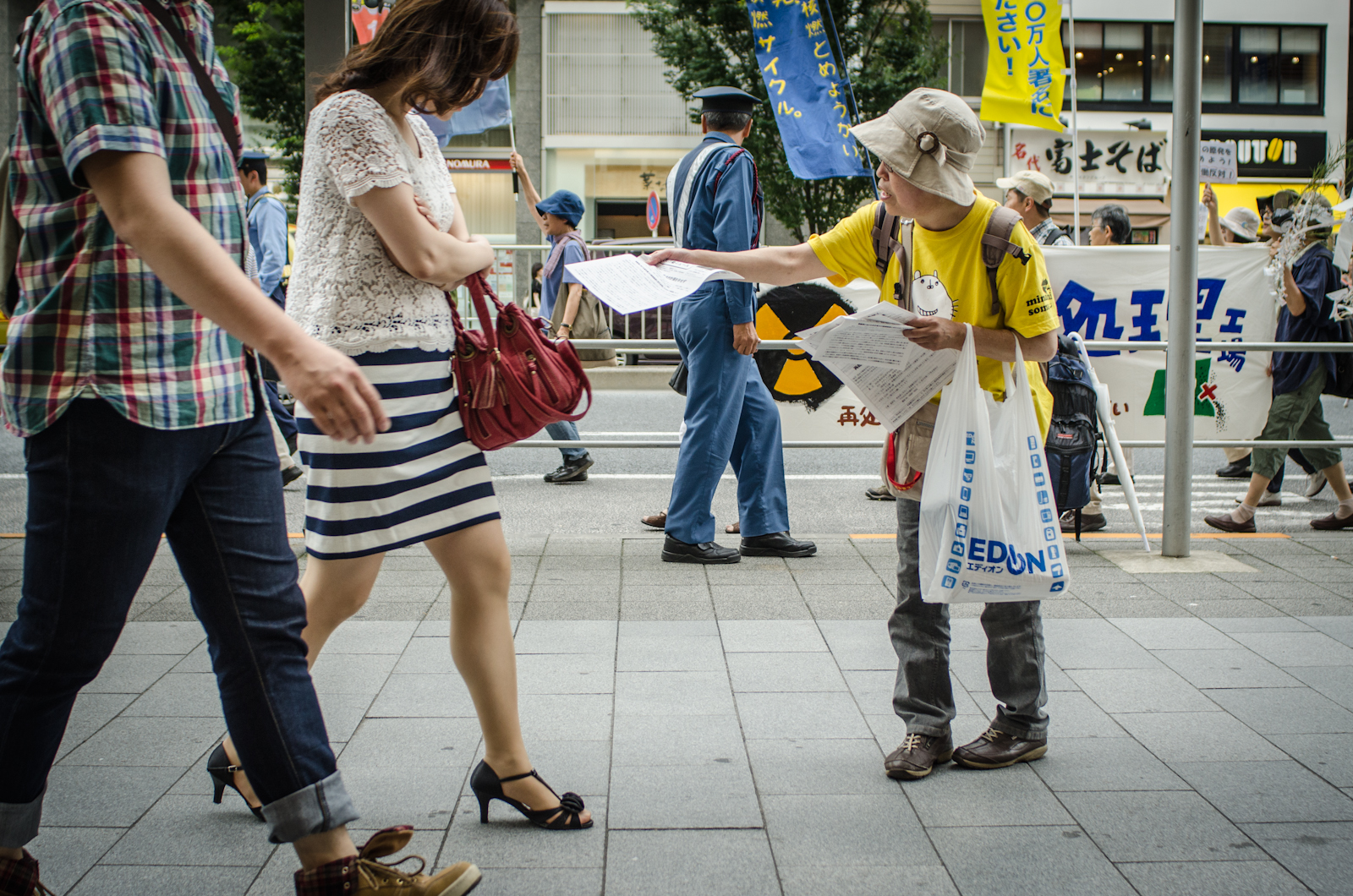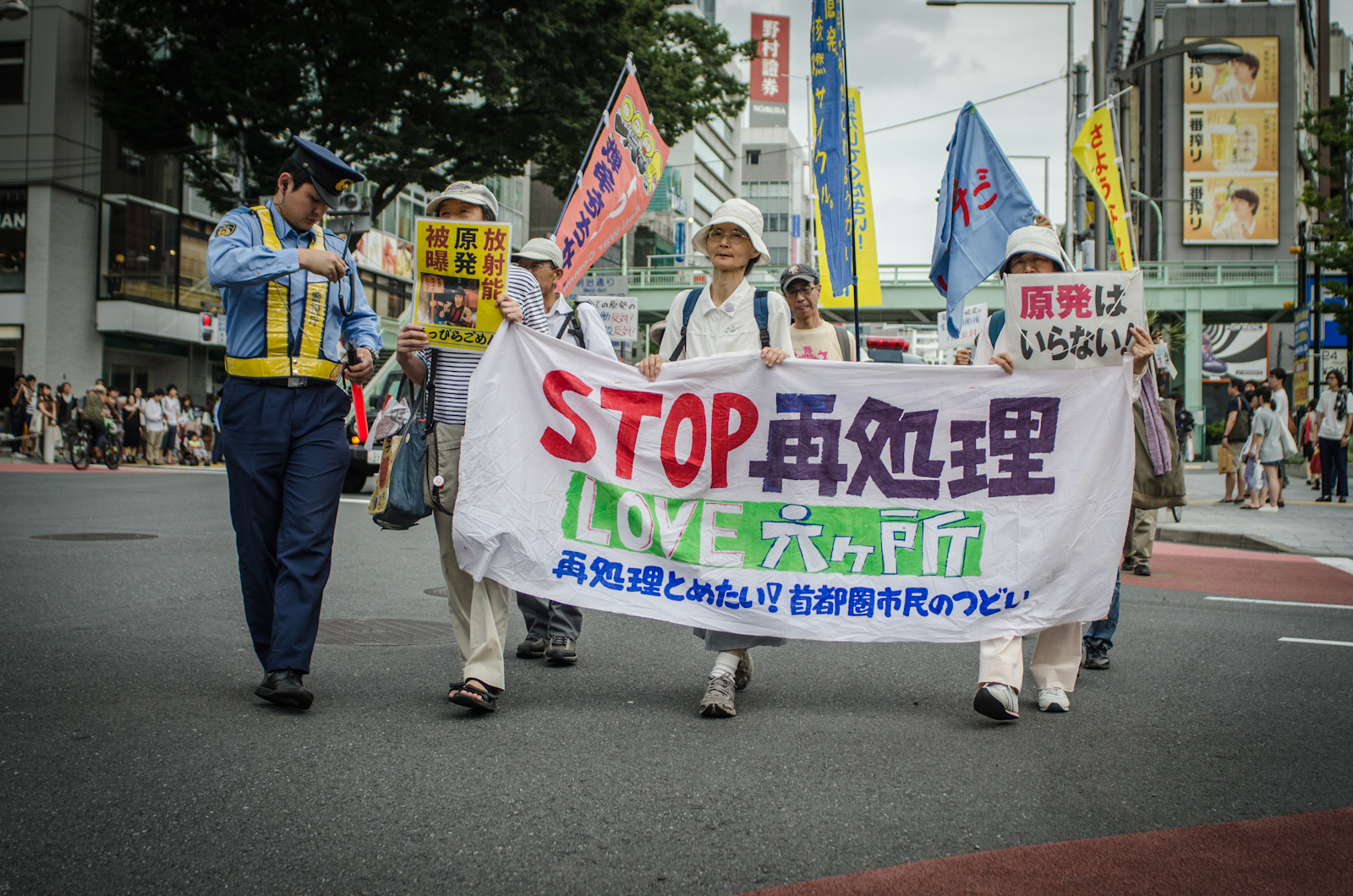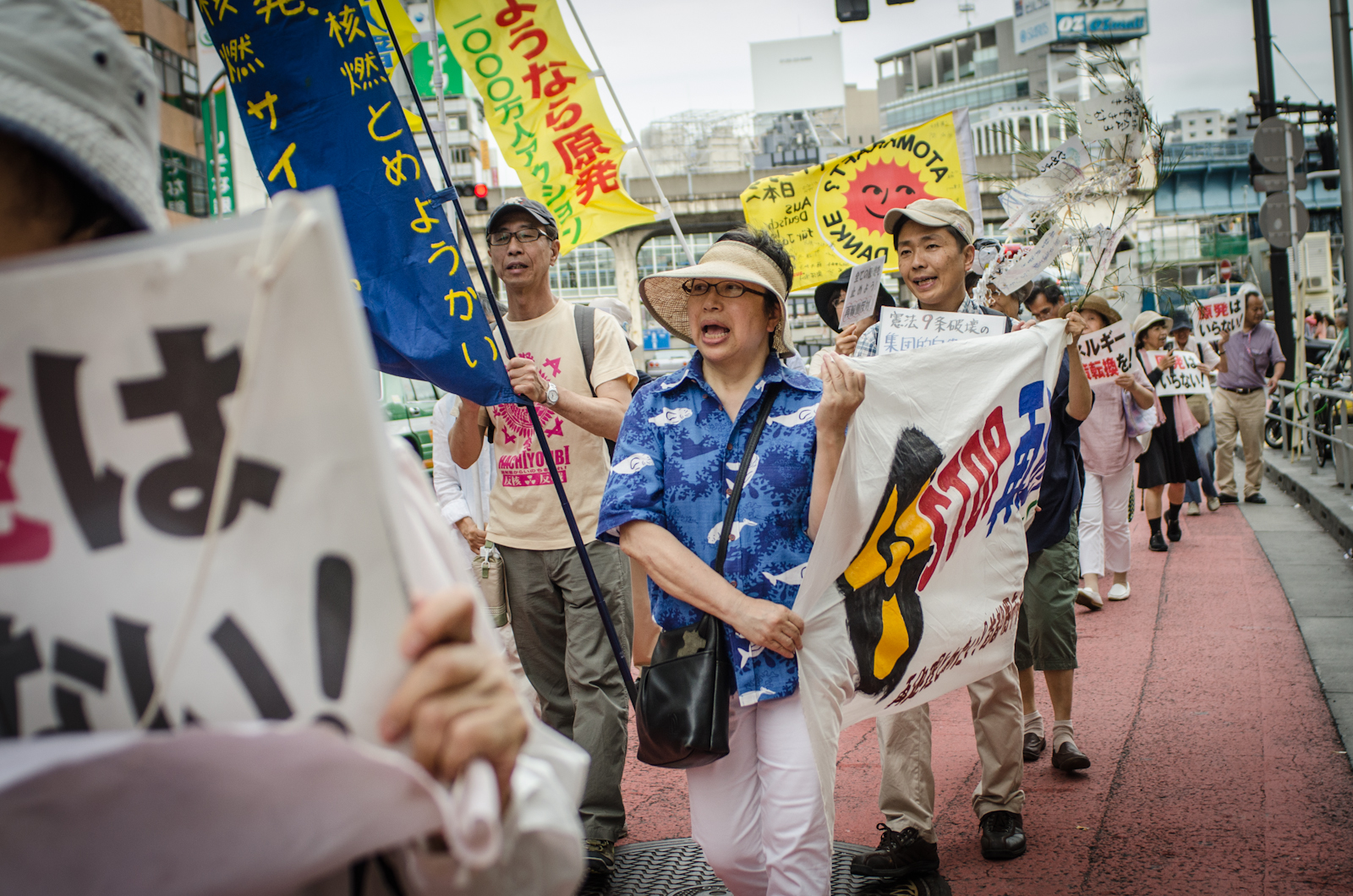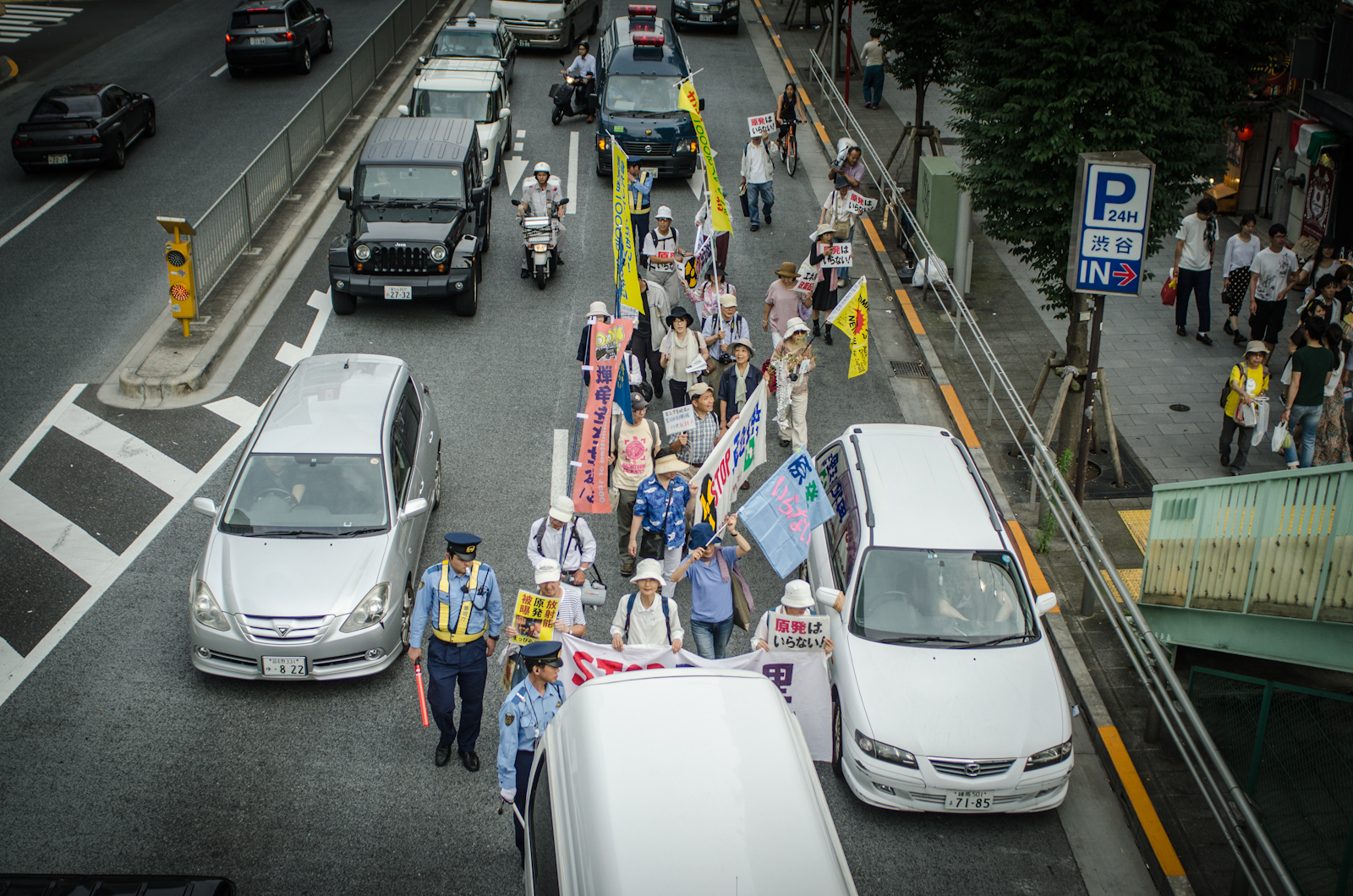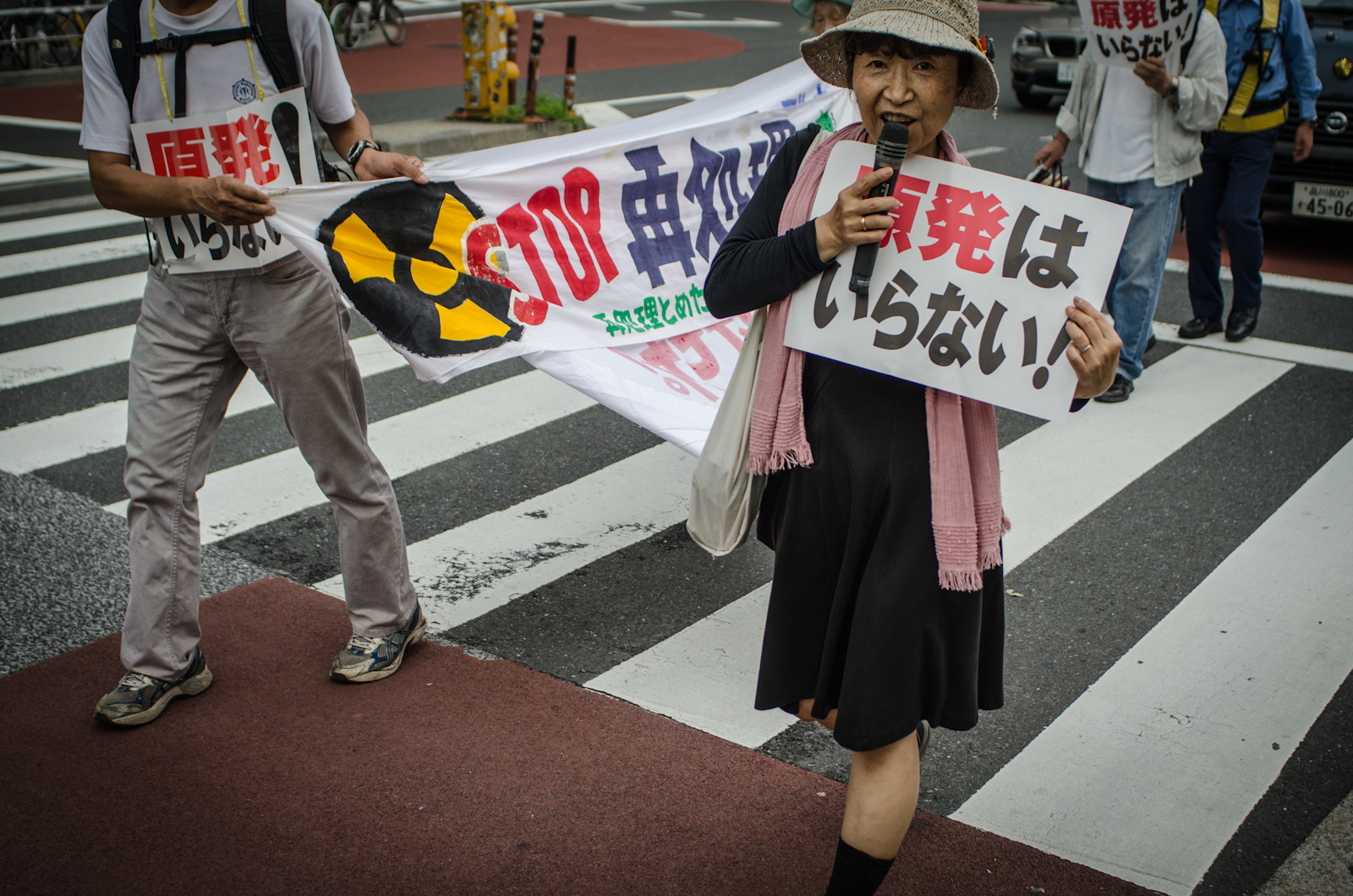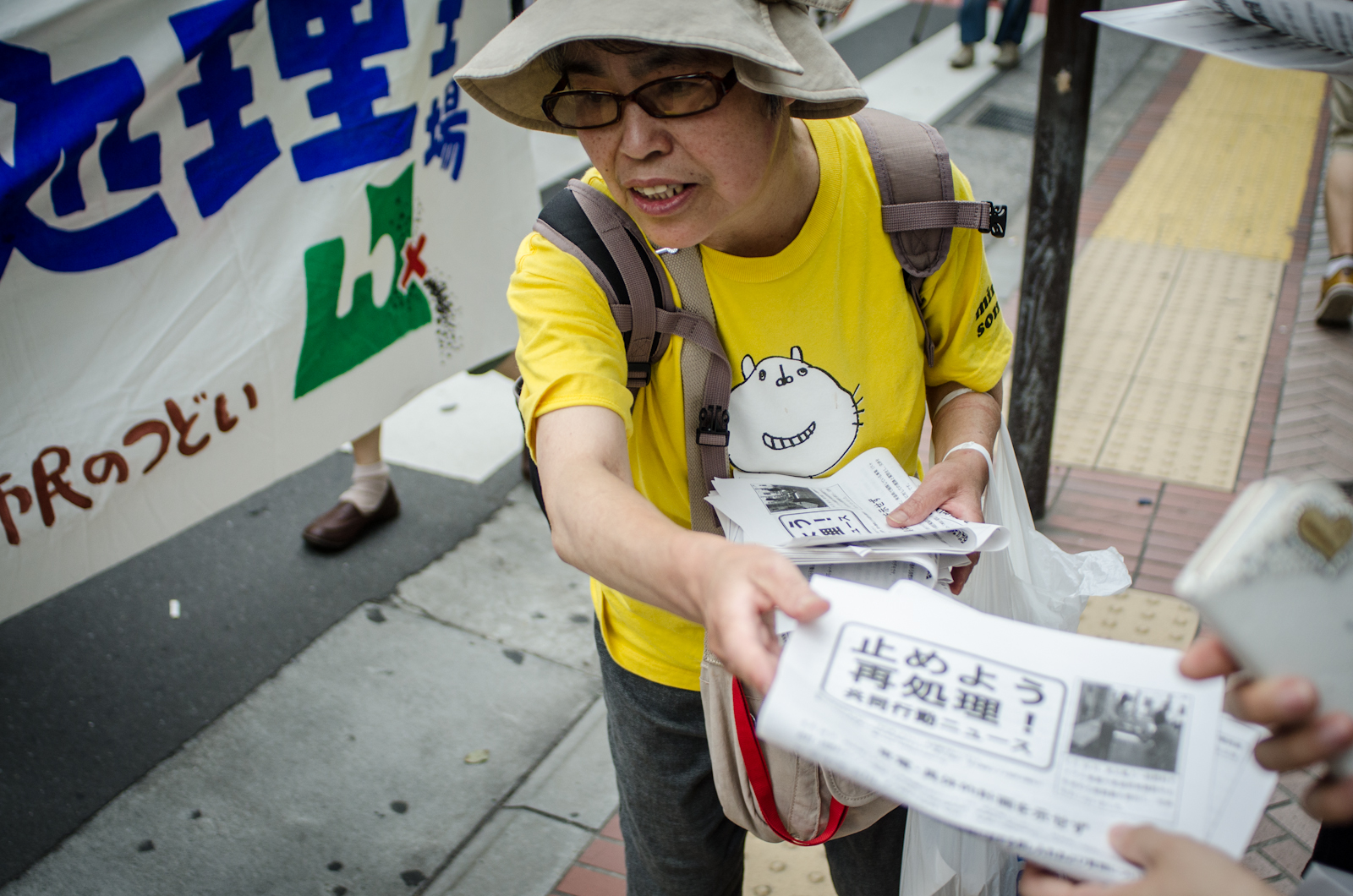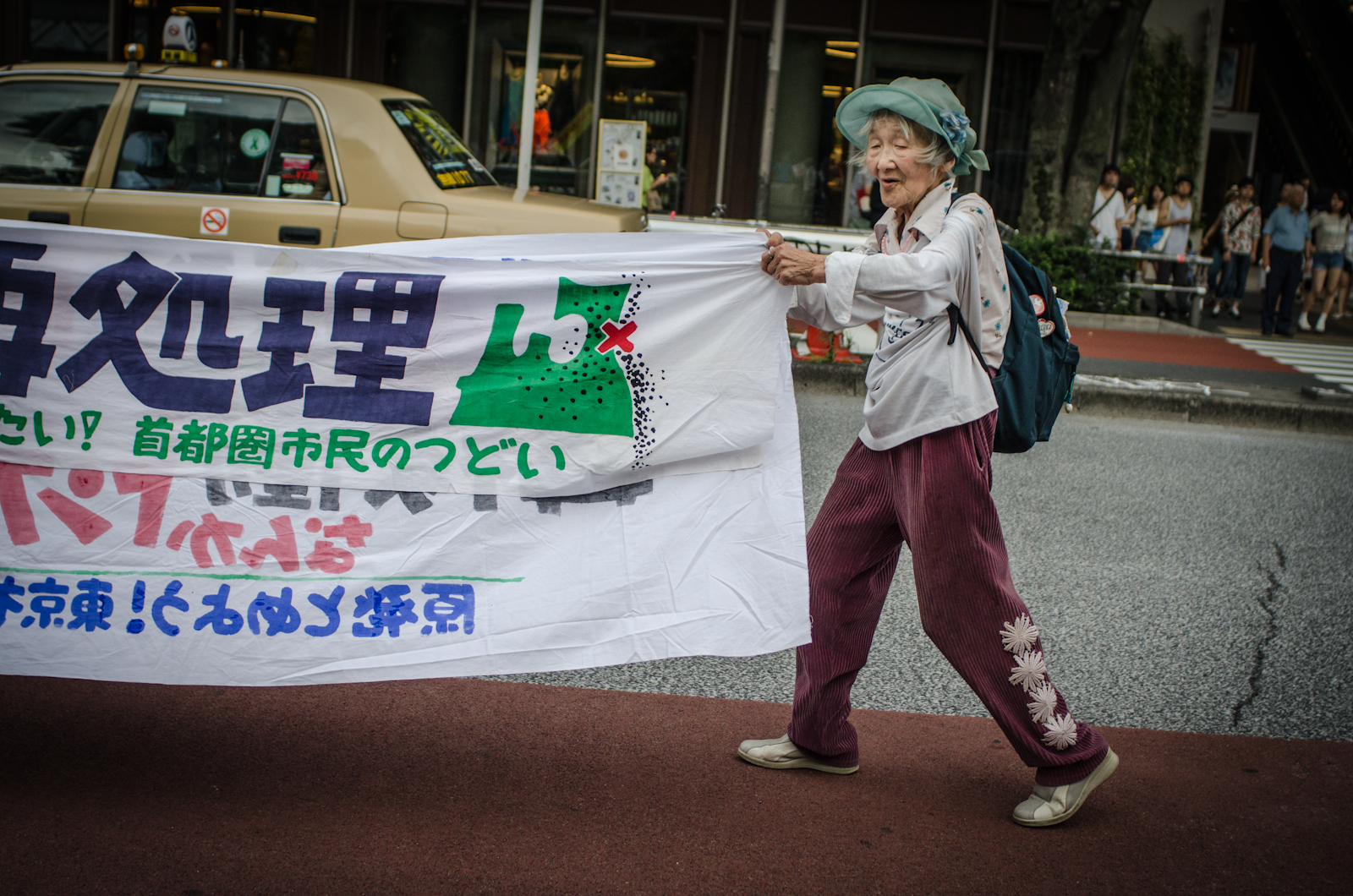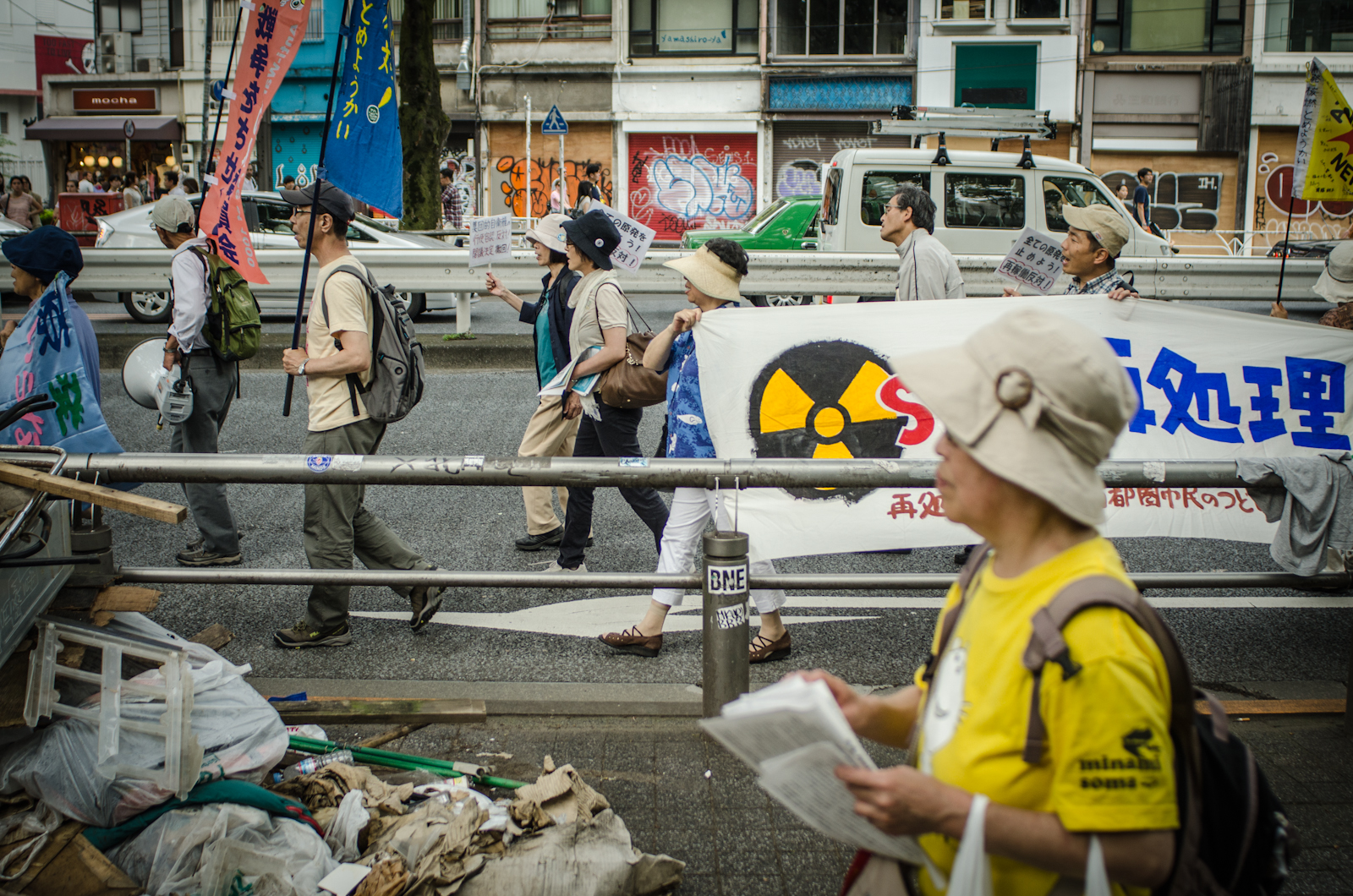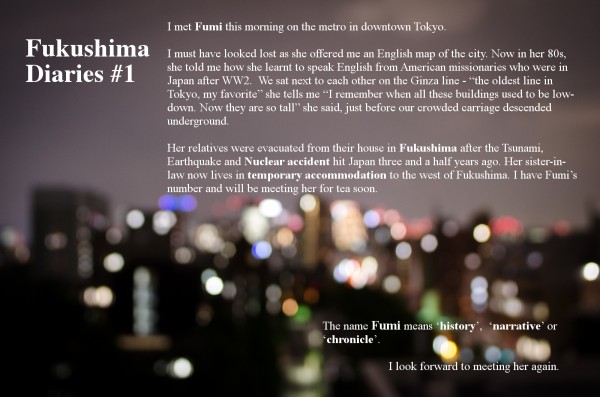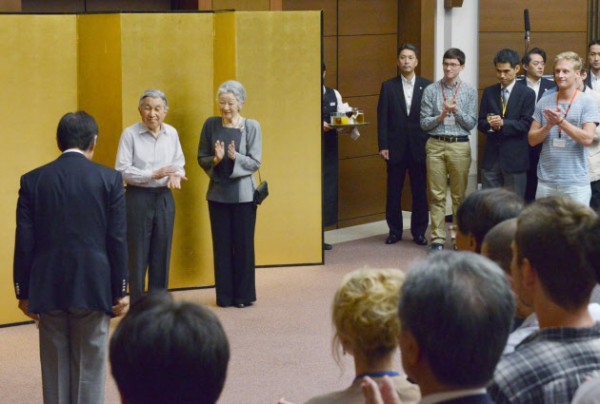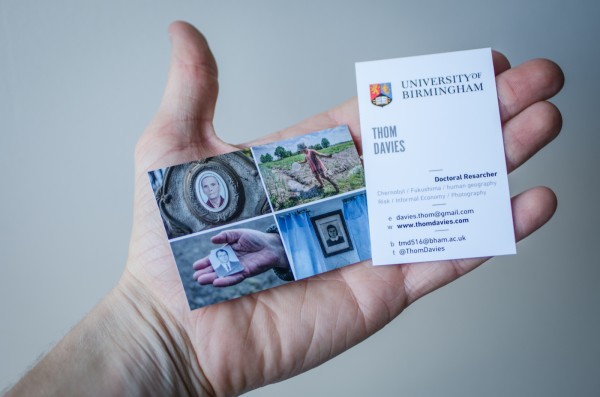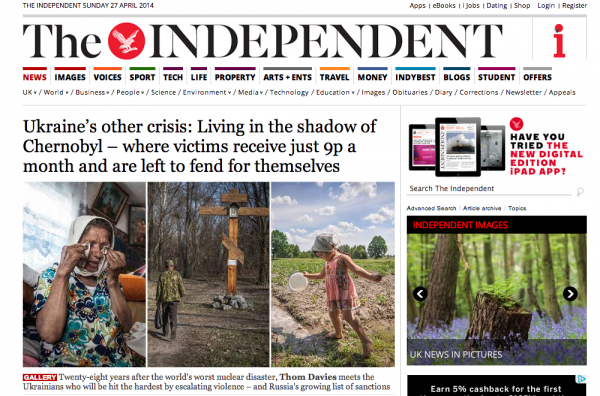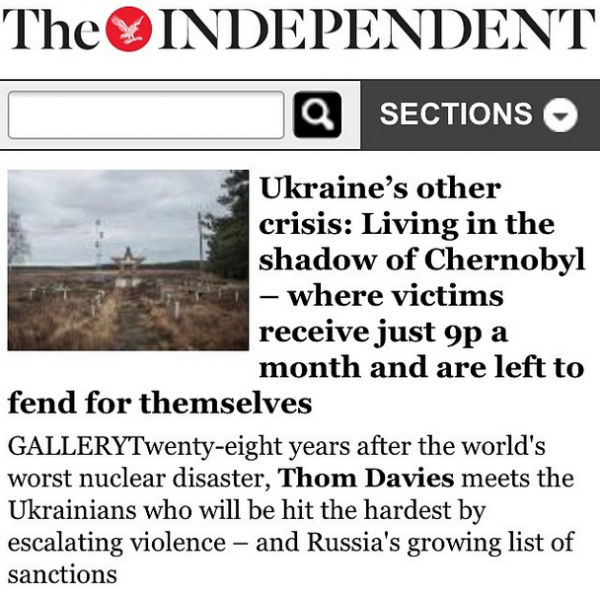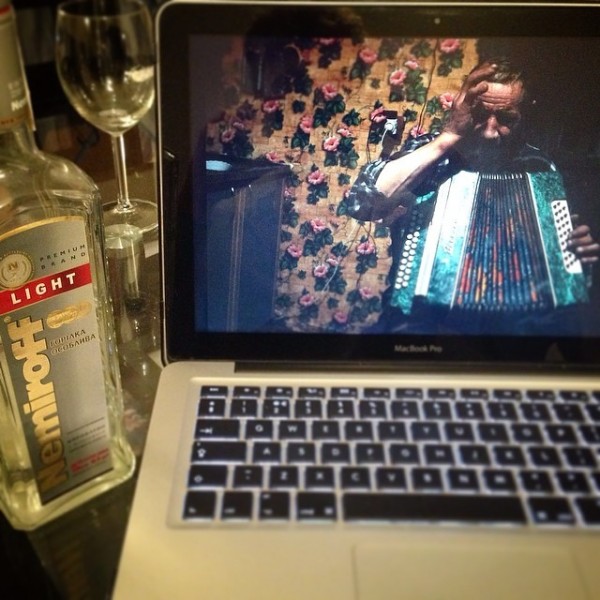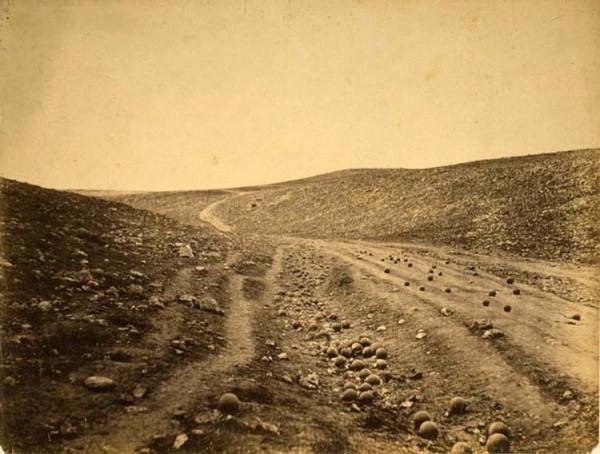On words and photography:
Putting words with photographs, especially quotations from interviews, can often change the meaning of an image. I was reminded of this recently when I visited the Photographer’s Gallery in London to see an exhibition about early Russian colour photography (reviewed by Lewis Bush here). Not least due to my ignorance of Russian photographic history, it was not until I read the captions, titles and image-descriptions that the photographs made sense; words changed their meanings.
I have hundreds of hours of recorded interviews with people who live near Chernobyl in Ukraine. They sit transcribed on my laptop, slowly working their way into my PhD thesis. I have started working on a small project called Chernobyl Interiors that matches some of these quotations with photographs I made in the intimate spaces of the participants’ houses around the Exclusion Zone.
So often Chernobyl is portrayed photographically as an abandoned, ‘dead’ and decaying place, but it is a landscape that people live with. It is home to many people who dwell in the shadow of uncertainty and nuclear pollution, but also by people who laugh, cry, fall in love and live lives that we would all recognise.
The photographs, like the one above are nothing special; they are rather banal interior shots of the homes I was invited into. But put next to quotations from people who live in these houses and they are transformed – perhaps even seen differently:
“My son was 23 and the other was 24
when they died. It was radiation from
Chernobyl.
I used to sing and play the accordion in
the local house of culture, but now
that my children are dead I don’t sing
anymore”
I remember this interview very well, a sad story of suffering and loss that was far from unique in this nuclear landscape. Though the quotation above gives no more than a ‘snapshot’ into this mother’s wider story, it also gives the photograph a new significance, and perhaps provides a deeper way of narrating the ongoing story of Chernobyl.
Susan Sontag – one of the more prominent scholars of photography – said:
“Photographs – and quotations – seem, because they are taken to be pieces of reality, more authentic than extended literary narratives”
There is an advantage of only seeing (or reading) a snapshot of a complex story; it discards the clutter and complexities of everyday life, distilling and framing a message to the viewer in a particular way. But with this comes its own set of problems. Photographs hide as much than they reveal: at best – sanitizing reality – at worst – changing it.
Photography, perhaps more than any other medium of communication, lays bare what Feminist-theorist Donna Haraway calls our ‘positionality’: The idea that all knowledge – be it contained within a photograph or in academic discourse – is created by individuals who are ‘situated’ with their own subjective perspectives and embedded within power structures that influence the creation of that situated knowledge.
Moreover, photography contains a unique disconnect – that photographs can simultaneously be both ‘fact’ and ‘subjection’. There is an unresolved tension between photography’s use to document ‘data’ (crime scenes, mugshots, war photojournalism, ‘evidence’ etc.), and the highly positioned nature of each photograph being a personal and curated slice of reality: each time a photographer raises the camera to their face to frame a picture they make a subjective choice.
Street photographer Garry Winogrand once commented on photography that:
“putting four edges around a collection of information or facts transforms it”
Of course the same can be said about a quote from an interview. Instead of four edges we use quotation marks, composing the spoken word from a choice of baggier utterances, leaving unwanted information outside the verbal frame.
In Chernobyl Interiors I want to be reflexive about this process, as both the images and quotes have been framed by my situated self. This is in contrast to my other Chernobyl project Disposable Citizens, in which people were given disposable film cameras to document their own lives and give their own view of their world.
The title of the exhibition I visited on early Russian colour photography was ‘Primrose’. I did not understand the significance of this until I watched an interview with the curator Olga Sviblova. She explained that Primroses are often the first flowers to bloom in the thaw of Spring after the long snow-covered darkness of Russian winters. They bring colour into Russia’s monochrome landscape. “Its like the sun arriving from the earth” she said, and with those words, it made sense.
# Chernobyl, Chernobyl Interiors, Gary Winogrand, photography, positionality, Susan Sontag
0 0
Reflecting on gender and nuclear disaster:
Over the course of my research in Fukushima I’ve had the pleasure of meeting farmers who continue to illegally farm within the nuclear Exclusion Zone. A couple of them – jokingly – compared themselves to ‘Kamikaze’ (神風) making it clear that their own health could be damaged for the greater good. Likewise, a friend of mine who is a Japanese policeman described his work in the Exclusion Zone after 3/11 in stoical terms, playing down his personal risk of exposure, or the difficulties of searching for post-Tsunami corpses, or having to contend with the heat of the anti-radiation suits in the stifling Japanese Summer:
“I was just doing my duty”
This idea of sacrifice seems to attach itself to nuclear disaster. The ‘liquidators’ of Chernobyl for example are also framed in a similar way: male heroes idolised in monochrome photographs, or cast in stone – sacrificing themselves for the greater good. The ‘Fukushima 50’ too, have become motifs of nuclear disaster, encapsulating this idea of the strong masculine hero.
What these have in common is gender. But my research in Fukushima has found other gendered realities – such as the bravery of the self titled ‘Mothers of Fukushima’ who – with their husbands unable or unwilling to leave Fukushima – managed to resettle in Tokyo single handedly; successfully campaigning for their right to welfare assistance, while looking after young children, even while pregnant. A different kind of sacrifice, but a brave move nonetheless. One mother, who relocated her three children from Fukushima described how “my son stopped eating after we evacuated, but my daughters were fine” She said, and then continued “That’s when I knew women were stronger!”
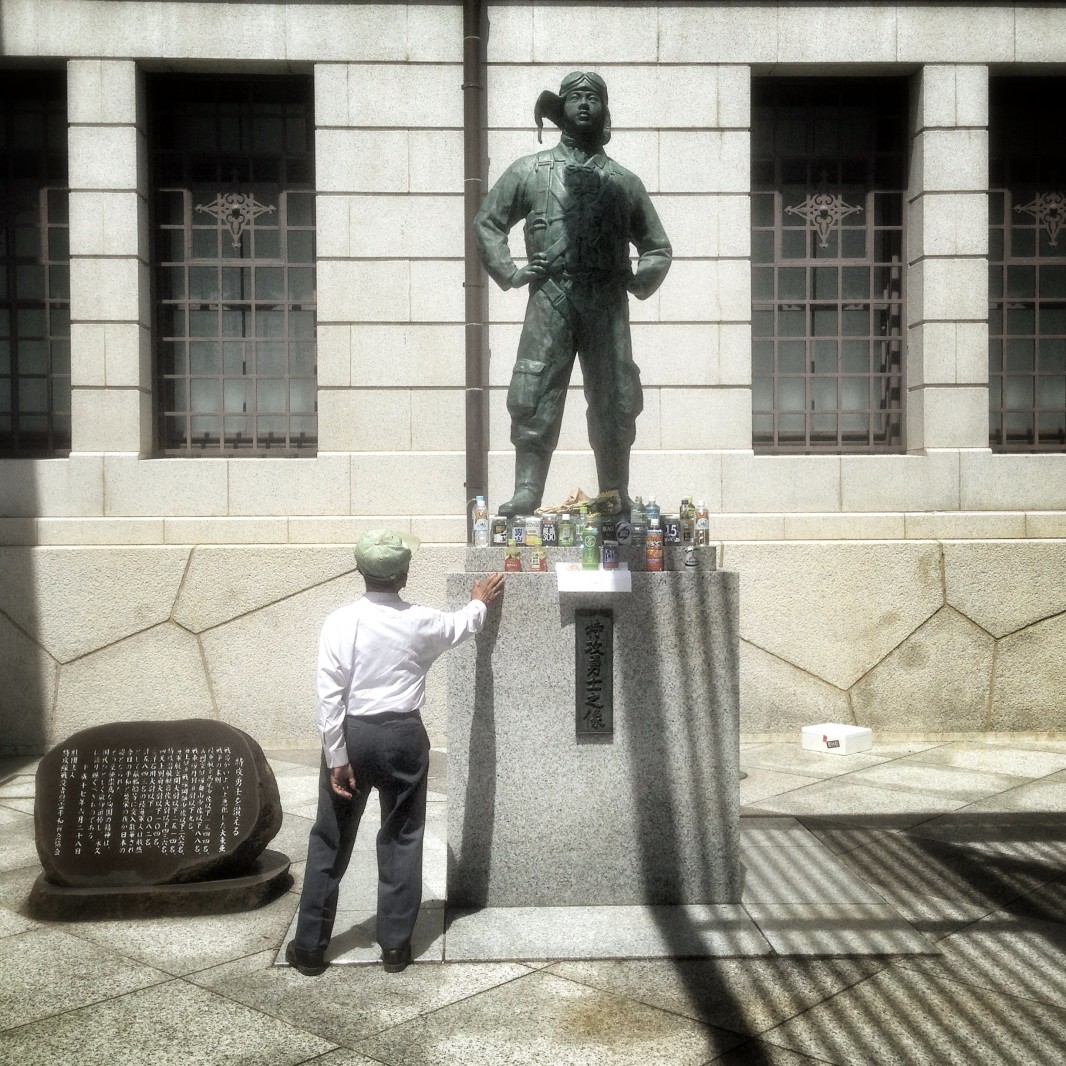
A Japanese War Veteran in front of a memorial to the 5000 Kamikaze pilots who sacrificed themselves during WW2
# Chernobyl, disaster, Fukushima, gender, kamikaze, nuclear accident, Thom Davies
0 3
Research diary outtake:
Travelling around the contaminated zones near Fukushima – my mind flashes back to Ukraine: the empty schools, the broken glass, the abandoned shoes. They are all visual clichés in the photographic portrayal of Chernobyl, repeated ad-nausea by countless ‘disaster tourists’ who traipse through Chernobyl on day trips from Kyiv. In Japan these visual tropes are once more offered for the lens, laid bare in the abandoned towns and villages near the Fukushima-Daiichi power plant. For someone who has spent much time in Chernobyl, Fukushima is unwelcomingly familiar.
“This is the field where the annual sports day used to be held…” explains one evacuee, over the sound of her Geiger counter“…all the parents would join in too” she remembered. She was here to visit her house in the ‘Red Zone’, which became highly contaminated with radiation after the huge earthquake and tsunami damaged the nuclear power plant in March 2011. She visits her house as much as possible, navigating the many police checkpoints with the necessary permission documents, and wearing a white contamination suit, mask, and gloves. At the end of the day we put our nuclear uniform in plastic bags. They’ll be put in large grey containers, with all the other uniforms that TEPCO workers and the mass of temporary workers (nuclear “gypsies”) have used over the years.
The school playing field is overgrown now. The tall grass slowly giving way to small samplings, that will one day become trees. It takes little imagination to hear the laughter of the kids who are now absent. On the eve of the World Cup final, here is a photograph from my mobile phone of the goal where football used to be played, just three and a half years ago:
Research diary outtake:
I went to an anti-nuclear protest in downtown Tokyo on Sunday. A few police were there to escort the protestors, occasionally stopping traffic and blowing their police whistles. It was an extremely controlled and polite affair. The police even told the protesters when and where to stop, which they promptly did.
It was a small protest by any standard, only twenty three people in total, the average age being somewhere in the mid-sixties. Holding anti-nuclear banners they chanted “No Nukes!” in English, and an elderly lady with a microphone made remonstrations about Fukushima through a megaphone.
I followed them as they slowly walked their way through the busy shopping district of Shibuya; moving at the pace of a funeral march – the police van ahead acting as their hearse. One protestor attempted to hand out flyers to the sea of shoppers who weaved past. Very often passers-by turned down the offer of a leaflet, politely bowing their head in rejection.
This small group of elderly protesters seemed so insignificant against the backdrop of Shibuya’s heaving intersection. The throng of faces waiting, texting, only occasionally glancing up – momentarily – at the comparatively unusual sight of a protest in Japan, before continuing on as they were.
In some ways it reminded me of a discussion I had last week at a ‘roundtable’ about Fukushima hosted by the the Foreign Correspondents Club of Japan. Several academics were there, as well as a Ukrainian diplomat and Japanese politician Tsuyoshi Shiina from the opposition ‘Unity Party‘ (結いの党).
The general consensus from the invited speakers was that the Fukushima accident has had relatively little impact on Japan’s political landscape. Much like how this small group of protesters was having little impact on the opinions of the thousands of uninterested onlookers.
What I took away from the roundtable about the political impact of Fukushima was both interesting and surprising. You can watch the whole discussion the video below.
At the time of writing we are almost three and a half years after the Fukushima nuclear disaster. A similar period of time after Chernobyl occurred in the ‘Ukraine Soviet Socialist Republic’ [Украинская Советская Социалистическая Республика] – the Soviet Union collapsed. Some academics such as Phillip Stone, Marjolein van der Veen, as well as myself, have attributed Chernobyl as a key factor leading to the sudden and unexpected implosion of the Soviet Empire. Chernobyl was, as one journalist reminded me at the Fukushima roundtable, the real start of Glasnost, of freedom of information. It showed for the first time the complete failure of the Soviet Union to protect its citizens.
In Japan there are no signs of such change. Given the far-reaching consequences of Chernobyl – might we expect more? In Japan there is no real questioning of the status-quo, at least at the national level, at least at the level of mainstream politics. The current government in fact, has never been stronger, with Prime Minster Shinzō Abe (安倍晋三) even able to pass a controversial law ending Japan’s constitutionally implied post-war pacifism.
Nuclear energy has not even become a totem around which opposition movements can pin their colours, as happened with Polish independence movements after Chernobyl. Instead we have the opposite – an entrenchment of political voices that means Japan’s energy landscape, which saw a reduction of nuclear power by 95% since 2010, will only be a brief hiatus in the onward march towards nuclear energy. The Fukushima-Daiichi accident is, then a mere bump in the road. In Japan the ‘nuclear village’ – as guest speaker Dr Christopher Hobson frames it – is as strong as ever, with the incumbent and opposition parties in Japan unable to offer any real alternative to nuclear power.
***
I guess one expects things that one looks at intensely to hold a stronger significance. We are perhaps all guilty of attributing greater significance to things we signify as important. Perhaps Chernobyl did not have that large an impact on the political landscape of the USSR, if Fukushima is anything to go by. Or perhaps the official political impact of disasters is the wrong measure, and skirts around the real impacts felt by the damaged and abandoned communities who always seem to preface nuclear disaster. Perhaps the undeniable social fallout – is where Chernobyl and Fukushima become uneasy bedfellows for comparison.
Chernobyl may not be the right lens through which to view all nuclear disasters, but its magnitude has fated each future meltdown to be compared – cheek by jowl. There is some truth in the cliché that ‘If you’re holding a hammer then everything starts to look like a nail‘. My hammer is four years of doctoral research about Chernobyl, so no surprise, then, that in my mind at least, Fukushima is the Chernobyl of the East. I’m hardly the first and won’t be the last to compare one with the other. It’s how we understand anything, through comparison, through metaphor.
The dissonance between the small group of elderly protestors marching slowly through Shibuya and the mass of passive onlookers glancing up with indifference reminded me of the political situation in Japan. It spoke to the disconnect between a disaster’s huge social impact, and its apparent limited impact on the political landscape.
***
Read more on Hobson’s research on the post-3/11 politics and nuclear power in his recent paper here.
Research diary outtake:
I met Fumi this morning on the metro in downtown Tokyo. I must have looked lost as she offered me an English map of the city. Now in her 80s, she told me how she learnt to speak English from American missionaries who were in Japan after WW2. We sat next to each other on the Ginza line – “the oldest line in Tokyo, my favorite” she tells me “I remember when all these buildings used to be low-down. Now they are so tall” she said, just before our crowded carriage descended underground.
Her relatives were evacuated from their house in Fukushima after the Tsunami, Earthquake and Nuclear accident hit Japan three and a half years ago. Her sister-in-law now lives in temporary accommodation to the west of Fukushima. I have Fumi’s number and will hopefully be meeting her for tea soon.
The name Fumi means ‘history’, ‘narrative’ or ‘chronicle’. I look forward to meeting her again.
# Fukushima, Fumi, Ginza Line, human geography, interview, JSPS, metro, snowballing, Tokyo
0 2
Combined with the heady mix of jet lag and a few glasses of white wine, meeting the Emperor of Japan was one of the more surreal moments of my life. I felt even more out of place as I was in a T-shirt and shorts – though the shorts have been skilfully cropped out by the photographer (below)
I met the Emperor Akihito – known as the ‘heavenly sovereign’ (天皇) of Japan – at a wine reception near Tokyo on the first day of my JSPS funded fellowship. I’ve been awarded the scholarship to research the ongoing impacts of the 2011 Fukushima nuclear disaster in comparison with my existing ethnographic study in Chernobyl, Ukraine. Hosted by the University of Tokyo, I will be conducting fieldwork with communities affected by the disaster.
I spoke with the head of the Japanese Imperial family, and his wife Empress Michiko, explaining my research and talking briefly about my experience of Chernobyl. The Emperor wished me every success in Japan.
What the Emperor was like:
He’s s a small man, in stature and height – fragile with age but pretty active for an octogenarian. When I met him he was purposely shuffling with an entourage and smile. He asked me some questions and spoke through a translator at times, though I would guess this has more to do with slight deafness than not being fluent in English. We were told to speak loudly and slowly when addressing ‘His Imperial Majesty’.
We were later told that he was also accompanied by a 250 strong security team, but they made their presence fairly subtle – though frankly, a group of researchers probably posed quite a low risk threshold.
We were not supposed to take any photographs, which is a shame. I would have loved an ‘Imperial Selfie’.
# Chernobyl, Emperor Akihito, Emperor of Japan, Fukushima, JSPS, JSPS Summer Program
0 4
I am getting ready to travel to Japan this summer to research the ongoing impacts of the Fukushima nuclear accident. I have been awarded a JSPS Fellowship to do Chernobyl-Fukushima comparative research, based at the University of Tokyo.
I am really looking forward to seeing how the two disasters compare. For the last few years I have spent long periods in Ukraine interviewing and researching people affected by Chernobyl for a PhD in Human Geography. Having seen how marginalized communities cope with nuclear disaster in Ukraine, it will be interesting to see if similar opinions, views and struggles are playing out near Fukushima.
Business Cards
When I mention to people that I am going to Japan, one of the first pieces of advice people give is to make sure I have business cards. I’m told there is a tradition that surrounds business cards in Japan; certain ways of receiving and presenting cards. So I had some made. They arrived today, and I am hoping they will help me make connections when I am in Japan studying the Fukushima disaster.
I put four photographs from my War without War: Chernobyl photography project on the back.
I was near Chernobyl when Fukushima happened
March 2011: in a village near the main entrance to the Chernobyl ‘Exclusion Zone’ we had pulled-over to listen to the radio. I kept hearing the word “Yaponiya” (Japan) and “atomny” (atomic) from the crackly car stereo. The newsreader then started talking about Chernobyl: “Reports suggest that the nuclear meltdown in Japan could be like another Chernobyl…” I could not believe what I was hearing. Was this really happening? I got out of the car.
I had spent the previous week interviewing people who live in the contaminated landscape around the Chernobyl. My head (and voice-recorder) was full of their stories about life after Chernobyl, their daily struggles of life on the edge. My was body full of delicious Ukrainian food I had been given by kind old women and friendly villagers.
Standing by the car, in a village near Chernobyl – the radio crackling in the background – I had a very small sense of the confusion and unease that many people felt after disaster. What was the future for Japan? I thought. What was happening? Looking across a field past a few abandoned wooden houses, I could see the contaminated ‘Exclusion Zone’ beyond. Was this the future?
Human geography beyond the ‘Ivory Tower’:
With all-eyes on Ukraine at the moment, I have published an article in The Independent that highlights the struggle of those who live with the consequences of the nuclear disaster in Ukraine. This is based on my academic research in Chernobyl-affected regions of Ukraine.The article has been the lead piece on The Independent website all Sunday and is getting a lot of traffic on twitter/facebook etc. I am glad that my research is reaching a wider audience and that this important topic is being spoken about.You can access a copy of the piece on my academia.edu page, or the original article here.Photographic images are key to telling this story. My own photographs and those of my very talented friend Alexey Furman can be seen in the original article.
I did not chose the title of the article – that privilege lies with the editor – but the rest are my words and the words of those I met:
Ukraine’s other crisis: Living in the shadow of Chernobyl – where victims receive just 9p a month and are left to fend for themselves
The yellow and blue flag of Ukraine is an imaginary landscape. It supposedly symbolizes the endless fields and blue skies of a Ukrainian rural idyll.
Gazing north near the border with Chernobyl, one can be forgiven for being taken in by this fantasy; the yellow unploughed fields stretching out to the horizon. The illusion is broken however, by a distant strip of green conifer trees and disused pylons where the sky meets the earth. Beyond these trees lies the Exclusion Zone.
“We are like bugs on a potato” explains Viktor, standing on his field that backs on to the barbed wire fence of Chernobyl’s nuclear Exclusion Zone: “These bugs are not afraid of anything and nor are we, if you try to kill them – they are still alive, and we are the same”. Like many others who live on territory officially deemed contaminated by Chernobyl, he receives just 9p per month in compensation to ‘buy clean food’. “What can I do with this?” he asks, “It won’t even buy a loaf of bread”.
As the turmoil in Ukraine intensifies and the physical violence enacted upon Ukrainian citizens by bullet, truncheon or Molotov cocktail continues, another more stealthy form of violence continues to impact the lives of thousands of people – that of state-abandonment. This weekend marks the 28th anniversary of the world’s worst nuclear tragedy. With Ukraine’s economy on its knees and Russia at its throat, it is Chernobyl’s marginalized citizens who rely on dwindling compensation that are placed at the thin edge of this geopolitical crisis.
Earlier this month Russia announced an 80% increase in gas prices for Ukraine. Likewise, the IMF loan offered by the West in the wake of Crimea’s annexation has come with many strings attached, namely a long list of austerity measures that make the 2010 deal with Greece seem like a philanthropic gesture. Kiev’s floundering interim government are curtailing social services and slashing benefits whilst a depression on a scale not seen since the collapse of communism seems inevitable.
Ukrainians, one in four of whom are already below the poverty line, lie sandwiched between two geopolitical antipodes and are set to feel the full force of these austerity measures and gas hikes. Perhaps no group more so than the exposed victims of Chernobyl.
“This is war without war” explains Masha, who lives a few minutes walk from the forbidden spaces of the Zone – a cordoned off area of north-central Ukraine roughly the size of Oxfordshire. Like Viktor, she too receives virtually nothing in terms of compensation. Her tiny state pension – barely enough to make ends meet – is set to decrease further in the first round of President Yatsinyuk’s austerity measures. “We have a lot of diseases too” she adds “I can’t sleep now”.
But she, like many others, has other ways of coping. She grows her own food in the contaminated soil, “cucumbers, potatoes, you name it” and even illegally sneaks through holes cut in the fence around Chernobyl, deep into the radiated forests to gather mushrooms and berries. Some she pickles in jars for the uncertain year ahead, and others are sold on the streets of Kiev. The police sometimes catch her in the Zone but they are often more interested in eliciting bribes than arresting her.
Others collect scrap metal from the Zone in their bid to survive an absent state and failing economy. “If you can, then you steal something, if you cannot steal something – you are hungry” explains one man who regularly ventures into the forbidden forest. Selling the abandoned detritus and infrastructure of the Zone, left by the thousands of forced evacuees 28 years ago, has become an informal lifeline to many people who live in the shadows of Chernobyl.
People affected by the tragedy have been exposed twice – once to the invisible threat of radiation, and once more to a state that does not care. Liquidators for example, who risked their health in the wake of nuclear meltdown to clean up the contaminated landscape, today regularly struggle to claim the compensation they deserve.
“Do I have to die to prove I am a liquidator?” asks one woman from Kharkhiv, desperate for compensation to help buy medicines for illnesses she relates to Chernobyl. Their damaged biologies and psychological scars are testament to a state that has failed them.
Estimates of fatalities from the disaster vary wildly, from the IAEA’s figure of 4000 up to nearly one million. But any number hides the real human cost of the tragedy: the lives ruined, the dismembered communities, and the invisible poison of stress.
“You should see the cemeteries there” Viktor tells me, referring to the places where the 350,000 Chernobyl evacuees were sent, “they are like cities”.
There is a widely held belief that those who were forcibly evacuated have died from stress. As one evacuee tells me, who now lives 500 miles away from her childhood home in the Exclusion Zone: “We are like a tree that has been uprooted, and taken from our own land. There’s only a small chance that this tree will survive and grow in the new soil.”
Recent months have seen Lenin statues forcibly removed from Ukraine’s urban landscape, but the nuclear legacy of the Soviet Union is harder to erase. It is an inheritance that consumes around 5% of Ukraine’s budget each year, a cost that the post-IMF government will be targeting in its path towards austerity.
The dust will eventually settle on the ongoing unrest in Ukraine. Borders may even change. But long after the world turns away from Ukraine, people like Viktor and Masha will still be there, struggling on the edge of a forgotten tragedy – like bugs on a potato, attached to the soil.”
– Photographs by Alexey Furman and Thom Davies
# Chernobyl, Chernobyl photography, The Independent, Ukraine crisis, Ukraine's other crisis
0 0
Vodka reflections:
I’m editing photographs from my research trips to Chernobyl in Ukraine. Tomorrow will mark the 28th anniversary of the disaster. Going through the photographs and interviews from Ukraine is reminding me of some of the most incredible experiences of my life, and the kindest people I know.I’m working late tonight to meet deadlines, but at 1:23am I will raise a glass of Nemiroff vodka to all those who were (and continue to be) affected by the disaster. Especially those I had the pleasure of knowing – some of whom are no longer here.
The photograph on the laptop above is part of the War without War photography project. It shows a photograph of Sasha, a great man I had the pleasure of spending time with.
War in Ukraine?
The first ever ‘War Photograph’ was taken in Crimea in 1854, by Robert Fenton titled ‘Valley of the Shadow of Death‘: Cannon balls strewn across a battlefield. As events unfurl in the region, let’s hope the next War Photographs wont be coming from the peninsula, or anywhere else in Ukraine.
